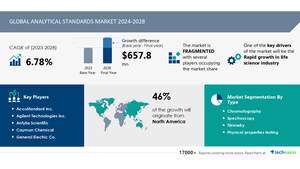NEW YORK, Oct. 2, 2024 /PRNewswire/ -- Report with the AI impact on market trends - The Global Laundry Care Products Market size is estimated to grow by USD 26.44 billion from 2024-2028, according to Technavio. The market is estimated to grow at a CAGR of over 4.83% during the forecast period. Rapid demand for laundry services is driving market growth, with a trend towards usage of eco-friendly laundry care products. However, harmful effects of chemical detergents on environment poses a challenge - Key market players include Amway Corp., Church and Dwight Co. Inc., Colgate Palmolive Co., Fena Pvt. Ltd., Godrej and Boyce Manufacturing Co. Ltd., Grab Green Home, Henkel AG and Co. KGaA, Jyothy Labs Ltd., Kao Corp., Lion Corp., Puracy, PZ Cussons Plc, Reckitt Benckiser Group Plc, RSPL Ltd., S.C. Johnson and Son Inc., Saraya Co. Ltd., The Clorox Co., The Procter and Gamble Co., Unilever PLC, and Venus Laboratories DBA Earth Friendly Products.
AI-Powered Market Evolution Insights. Our comprehensive market report ready with the latest trends, growth opportunities, and strategic analysis- View your snapshot now
Forecast period |
2024-2028 |
Base Year |
2023 |
Historic Data |
2018 - 2022 |
Segment Covered |
Distribution Channel (Offline and Online), Product (Laundry detergent, Fabric softener, and Others), and Geography (APAC, North America, Europe, South America, and Middle East and Africa) |
Region Covered |
APAC, North America, Europe, South America, and Middle East and Africa |
Key companies profiled |
Amway Corp., Church and Dwight Co. Inc., Colgate Palmolive Co., Fena Pvt. Ltd., Godrej and Boyce Manufacturing Co. Ltd., Grab Green Home, Henkel AG and Co. KGaA, Jyothy Labs Ltd., Kao Corp., Lion Corp., Puracy, PZ Cussons Plc, Reckitt Benckiser Group Plc, RSPL Ltd., S.C. Johnson and Son Inc., Saraya Co. Ltd., The Clorox Co., The Procter and Gamble Co., Unilever PLC, and Venus Laboratories DBA Earth Friendly Products |
Key Market Trends Fueling Growth
The laundry care products market comprises items made from chemicals, enzymes, surfactants, and bleaches. Some chemicals can negatively impact user health. Phosphates in detergents enhance cleaning efficiency but contribute to eutrophication when released into water bodies. Governments promote eco-friendly production, reducing phosphate usage and environmental harm. Alternatives like soap nut-based, 100% organic, and biodegradable green laundry detergents are available. Manufacturers focus on sustainable practices, producing safe, non-toxic products. Eco-friendly vendors, such as Eco Nuts Organic Products and Puracy, offer USDA Organic and Natural Baby detergents, free from harsh chemicals. The growing consumer preference for eco-friendly laundry care products is a significant market trend, driving market growth in the forecast period.
The Laundry Care Products market is witnessing significant growth, particularly among middle class customers seeking effective household cleaning solutions. Bacteria are a major concern, leading to the demand for bacteria-fighting detergent and aides. Both organic and chemical detergents are popular, with organic options gaining traction due to their eco-friendly appeal. Surfactants, such as alkylphenol ethoxylates, are key ingredients, but their environmental impact is under scrutiny. The real estate industry and working population drive demand for laundry detergent products, available through offline and online channels. Biodegradable items, high-end products, and fabric care are trends. Hygiene, germs, dust, filth, stains, and dirt are common laundry challenges. Fragrance is a key differentiator, with consumers preferring natural and organic options. The organized retail sector caters to the growing demand for eco-friendly, sanitary living products. The market also addresses concerns about fish and the endocrine system, metabolism, and the impact on the environment.
Insights on how AI is driving innovation, efficiency, and market growth- Request Sample!
Market Challenges
- Detergents, available as powders or concentrated solutions, are essential household items. Their effectiveness comes from their amphiphilic nature, which allows the combination of hydrophobic substances with water. Surfactants, the primary detergent component, are typically anionic, such as linear alkylbenzene sulfonate (LAS). However, the use of such detergents raises environmental concerns. The concentration of surfactants in water can be toxic to aquatic life, including microorganisms, which are crucial for nutrient recycling and ecosystem health. Harmful chemicals like chlorine, trichloroethane, sodium triphosphate, and surfactants can lead to water eutrophication and algal blooms, releasing toxins. The US Environmental Protection Agency (EPA) deems these chemicals toxic and harmful to aquatic life, with high carbon footprints ranging from 1.3 to 1.9 pounds. Some detergents make water acidic, negatively impacting the environment. Consumers often remain unaware of the toxic substances in detergents, posing potential health risks. Regulations, such as EU Regulation No. 648/2004, mandate detergent manufacturers to disclose surfactant information and develop biodegradable alternatives to meet environmental standards. These factors are expected to decrease sales of laundry care products due to their adverse environmental impact.
- The Laundry Care Products market faces several challenges. Detergent effectiveness on premium clothes is a concern. Young population prefers specialty stores and independent retailers, while e-commerce companies dominate sales. Personal hygiene products like sanitizers, soaps, and disinfectants are in high demand due to the ongoing health crisis. Harmful chemicals in synthetic laundry detergents can harm skin. Eco-friendly packaging and sustainable manufacturing are essential for millennials. Online distribution channels, e-commerce platforms, and grocery stores are key sales channels. Production facilities must adapt to social media penetration and cater to various fabric types, including denim, cotton, linen, microfiber, polyester, nylon, rayon, velvet, silk, lycra, wool, and acrylic. Washing machines and cleaning chemicals like bleach are also crucial. Bleach compatibility with different fabric types and eco-friendly alternatives are essential considerations. E-commerce behemoths and retail outlets must address consumer concerns about harmful chemicals and eco-friendly packaging. Manufacturing industries must innovate to meet these challenges and cater to the diverse needs of consumers.
Insights into how AI is reshaping industries and driving growth- Download a Sample Report
This laundry care products market report extensively covers market segmentation by
- Distribution Channel
- 1.1 Offline
- 1.2 Online
- Product
- 2.1 Laundry detergent
- 2.2 Fabric softener
- 2.3 Others
- Geography
- 3.1 APAC
- 3.2 North America
- 3.3 Europe
- 3.4 South America
- 3.5 Middle East and Africa
1.1 Offline- The Laundry Care Products market is a significant sector in the consumer goods industry. Companies manufacture and sell various products such as detergents, fabric softeners, and stain removers to meet consumers' laundry needs. Market growth is driven by factors like increasing population, rising disposable income, and changing consumer preferences. Competition is fierce, with major players focusing on product innovation, pricing strategies, and distribution channels to gain market share. Companies also prioritize sustainability and eco-friendliness in their offerings to cater to growing environmental concerns.
Download complimentary Sample Report to gain insights into AI's impact on market dynamics, emerging trends, and future opportunities- including forecast (2024-2028) and historic data (2018 - 2022)
The Laundry Care Products market encompasses a range of items designed to maintain fabric care and promote cleanliness for garments, furniture, and other textiles. These products include cleaning agents such as synthetic laundry detergents, fabric softeners, and bleach, which help remove stains, kill germs, and enhance the appearance of fabrics. Eco-friendly alternatives, free from harmful chemicals, are increasingly popular due to concerns over skin health and the environment. Hygiene is a key consideration, with sanitary living driving demand for effective cleaning chemicals. Various fabric types, including acrylic, denim, cotton, linen, and microfiber, require specific care and may benefit from laundry additives. Eco-friendly packaging is also a growing trend, reflecting consumer preferences for sustainable solutions.
The laundry care products market encompasses a wide range of fabric care and cleaning solutions designed to maintain hygiene and enhance the appearance of garments and household textiles. These products include laundry detergent, fabric softeners, and various cleaning agents such as sanitizers, soaps, and disinfectants. Eco-friendly options, free from harmful chemicals, are increasingly popular as consumers prioritize personal and environmental health. The real estate industry and premium clothes market drive demand for these products, particularly among the young population and middle class customers. Specialty stores, independent retailers, online distribution channels, and e-commerce platforms cater to diverse consumer preferences. The manufacturing industries produce a vast array of fabrics, from cotton and linen to synthetic materials like microfiber, polyester, and nylon, all requiring specific laundry care. Household cleaning goods, including bleach and cleaning chemicals, often overlap with laundry care products. Social media penetration and millennials' preference for sustainable packaging contribute to market growth. However, concerns over the impact of chemicals on skin and the environment, as well as the potential harm to aquatic life and the endocrine system, necessitate ongoing research and innovation in the sector.
1 Executive Summary
2 Market Landscape
3 Market Sizing
4 Historic Market Size
5 Five Forces Analysis
6 Market Segmentation
- Distribution Channel
- Offline
- Online
- Product
- Laundry Detergent
- Fabric Softener
- Others
- Geography
- APAC
- North America
- Europe
- South America
- Middle East And Africa
7 Customer Landscape
8 Geographic Landscape
9 Drivers, Challenges, and Trends
10 Company Landscape
11 Company Analysis
12 Appendix
Technavio is a leading global technology research and advisory company. Their research and analysis focuses on emerging market trends and provides actionable insights to help businesses identify market opportunities and develop effective strategies to optimize their market positions.
With over 500 specialized analysts, Technavio's report library consists of more than 17,000 reports and counting, covering 800 technologies, spanning across 50 countries. Their client base consists of enterprises of all sizes, including more than 100 Fortune 500 companies. This growing client base relies on Technavio's comprehensive coverage, extensive research, and actionable market insights to identify opportunities in existing and potential markets and assess their competitive positions within changing market scenarios.
Technavio Research
Jesse Maida
Media & Marketing Executive
US: +1 844 364 1100
UK: +44 203 893 3200
Email: [email protected]
Website: www.technavio.com/
SOURCE Technavio

WANT YOUR COMPANY'S NEWS FEATURED ON PRNEWSWIRE.COM?
Newsrooms &
Influencers
Digital Media
Outlets
Journalists
Opted In




Share this article